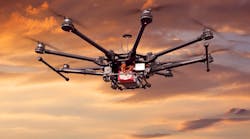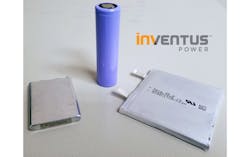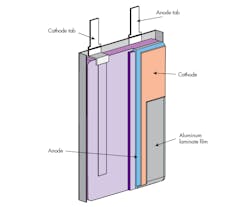Design Essentials: For UAVs and Drones, Batteries are Included
Download the PDF of this article.
Unmanned aerial vehicles (UAVs) and drones come in all sizes, ranging from hand-launched micro-UAVs to large-scale versions that utilize jet propulsion, internal combustion engines, or electric motors. When it comes to in micro-UAVs and smaller format UAVs, the most common method power are Lithium-ion (Li-ion) battery configurations that power the electric motors. Common requirements for UAV batteries include high energy/weight ratio, high discharge rates (five-minute to two-hour missions), resilience to shock and vibration, and fuel gauging to indicate remaining mission time.
Battery packs are more than a simple configuration of cells. They are carefully engineered products with many safety features. The main components of a battery pack include the cells (the primary energy source); the battery management system (a printed circuit board assembly) that provides the intelligence of the system, with features such as the fuel gauging and protection circuitry; the enclosure (either a plastic enclosure, plastic exoskeleton frame, or shrink-wrap PVC wrapper); and external contacts or connectors. Figure 1 shows all the elements that go into a conventional Li-ion battery pack.
Cell Options for UAV Batteries
Li-ion cells come in three basic form factors: cylindrical, prismatic (rectangular brick shape), and flat Lithium polymer cells. The most commonly used Li-ion cell is the cylindrical 18650 cell, which utilizes a steel or aluminum can. Prismatic or brick-shaped cells are available in a myriad of rectangular sizes, and are packaged in a metal can. Lithium Polymer (Li-Po) cells, sometimes called laminate cells, can be encased in flexible aluminum foil laminate pouches that are just 0.1 mm thick, versus the 0.25 to 0.4 mm thick metal cans traditionally used with cylindrical or prismatic cells. Because of the lighter packaging of the Li-Po cell, it is the cell of choice for most UAV manufacturers. These three types of cells are presented in Fig. 2.
The biggest advantage of Li-Po cells is the variety of available sizes. Because Li-Po cells are often custom-sized and the manufacturing process is easily configurable, these cells are available in a myriad of sizes and a variety of shapes. Figure 3 illustrates the construction of a Li-Po cell. They are assembled by stacking electrode and electrolyte materials in layers, rather than winding them around a mandrill and then inserting them into a hard metal can, as with other cylindrical or prismatic cells. Li-Po cell capacities range from 50 mAhr or smaller for applications like smartwatches to 50 Ahr or more for a cell tailored to light electric vehicle use.
1. The main components include the cells, printed circuit board assembly, enclosure, and external contacts or connectors.
Mission Time Drives Chemistry Selection
There are two chemistry classes for Li-Po cells. The vast majority of them are Cobalt Oxide (CO), Nickel Manganese Cobalt (NMC), or a blend of the two chemistries. The voltage range is from 3 Volts on the low end to 4.2 Volts at the top of charge, with a nominal voltage of 3.7 Volts. A minority of the Li-Po cells available are based on Lithium Iron Phosphate (LFP), which operates at a nominal 3.2 Volts. Although LFP cells operate at a lower voltage, their discharge rates can be much higher than typical NMC cells, making them a great choice for short missions.
Most UAV manufacturers have a bias toward using Li-Po cells over conventional cylindrical or prismatic cells. This is primarily driven by the lighter (non-metallic) packaging of the Li-Po cells, which inherently provides a slightly better energy/weight ratio. The main parameters that drive the selection of chemistry are the mission time. A short mission time (like five minutes) drives the chemistry selection towards a high-rate NMC or LFP chemistry, which offers high current discharge—and unfortunately, a lower energy/weight ratio. A longer mission time (such as two hours) drives the chemistry selection towards a more common moderate-rate NMC Li-Po chemistry, which offers moderate rate discharge and the best energy/weight ratio.
The high-rate NMC or LFP Li-Po cells can support a 20C rate discharge continuously, with a peak discharge rate of 40C. These high-rate cells have low impedance and support both high discharge and charge rates. This enables fast charge, or allows fewer cells per battery pack. Unfortunately, the energy density of these high-rate cells is lower than moderate-rate Li-Po cells.
Compared to cylindrical or prismatic Li-ion cells, Li-Po cells are slightly more expensive per watt-hour for several reasons. The high-quality laminate material and the special tabs that allow sealing against the bag are costly. Secondly, the lower speed of manufacturing increases both labor and overhead costs. Finally, while lower production runs allow for size flexibility, it results in lower yields and higher prototyping costs. Fortunately, the notebook market has transitioned from cylindrical to Li-Po cells over the last few years, and this trend has helped drive down the cost per watt-hour for Li-Po cells.
Physical Features of Li-Po Cells
There are some misconceptions about Li-Po cells with respect to the seemingly flexible packaging. The soft outer shell of the cell decreases weight and eases manufacturing constraints; it is not to give flexibility to the cell itself. In general, Li-Po cells should remain flat when installed in a device, although recently cells have been introduced to the market which can be curved for installation into the battery system. These curved cells allow Li-Po batteries to be used in ergonomic features such as a headband or wristwatch.
However, repeated bending of the cell brings the anode and cathode materials closer together, which can cause preferential plating and shorting. This structural damage may result in reduced cycle life and presents a potential safety hazard. In addition, the soft packaging on Li-Po cells can be easily punctured so special care must be taken in the manufacturing process.
A Li-Po cell, compared to a cylindrical cell, has less volumetric energy density, but more specific energy density, making them attractive for UAVs. Cylindrical cells have very high electrode densities due to their strong metal can, while the Li-Po cells do not have the added weight of the can itself. However, this disadvantage in energy density can be overcome by the advantage in packing density. Since Li-Po cells have a rectangular shape, they can pack tighter and utilize the lost space found in an equivalent cylindrical cell configuration. In addition, cylindrical cells are a fixed size, so they may not optimally use all the space available in the battery compartment within the UAV.
Design Considerations for Li-Po Packs
2. Li-ion cells come in three basic form factors: cylindrical, prismatic (rectangular brick shape) and the flat Lithium polymer cells.
As mentioned above, puncturing a cell is a much larger risk for a Li-Po cell compared to one in a steel or aluminum can. An internal short circuit will cause the cell to get hot, and thermal runaway is the worst potential outcome. Even if assembly damage doesn’t short the cell, a leak may allow moisture into it. Moisture will eventually cause the cell to self-discharge and prematurely fail. Swelling may result from the reaction of the anode with moisture.
With any Li-ion based chemistry, when the cell voltage drops too low (~1.5V), reactions at the anode produce gas. Over-discharge is an issue for all Li-ion cells, but the resultant gassing in Li-Po cells is more obvious—though also less dangerous. The cells will swell over time, but excess gas is released in a less violent manner than in a cylindrical or prismatic cell. Regardless of the chemistry type, the Battery Management System (BMS) embedded in the battery pack should be designed to prevent over discharge.
Overcharge has similar effects on battery health. The discharge of gasses occurs at the cathode as the electrolyte starts to decompose at high cell voltage (~4.6V). Swelling helps to prevent further overcharge by increasing the cell impedance as a final safety measure, but an external thermal fuse (connected to the BMS) should be employed for overcharge protection, in addition to charge control by the charger.
Given the increased possibility of puncture, over-heating, and swelling with Li-Po cells, it is always encouraged for UAV manufacturers to consider a plastic enclosure with enough extra volume to accommodate some level of swelling of the enclosed cells. This enclosure protects the cells from puncture, protects the operator from over-heated cells, and contains leaked electrolyte in the event of a cell rupture. However, many UAV manufacturers opt for a shrink-wrap packaging or a plastic exoskeleton frame to save on weight.
Rough or Smooth Landings
3. Li-Po cells are encased flexible aluminum foil laminate pouches that are just 0.1-mm thick, making them light and the primary choice for most UAV manufacturers.
UAV batteries that must pass portions of MIL-STD-810 Environmental Qualification are required to be contained in a light enclosure material to support shock and vibration testing. A material such as PC/ABS (Polycarbonate/Acrylonitrile Butadiene Styrene) offers good-notched impact, is flame retardant, and is ductile at lower temperatures for improved impact properties. This allows some of the impact energy to be absorbed by the enclosure and not transmitted to the cells and printed circuit board assembly within the enclosure.
Ultrasonic welding ensures the enclosure is resistant to shock or impact, as the resultant joint strength can match the strength of the welded material. More commonly, the UAV batteries are enclosed in primitive shrink-wrap PVC material or a plastic exoskeleton frame if the battery needs some extra structural integrity.
Regardless of the type of enclosure used to house the battery, the battery needs adequate structural integrity to pass the UN/DoT 38.3 Transportation Tests for Lithium Batteries. This set of tests includes the Vibration (T3), Shock (T4), and Impact (T6). This testing ensures that the battery, in combination with the battery packaging, can be safely shipped via commercial ground, ocean, or air transport. Ironically, many defense agencies that own and operate UAVs provide their own transportation for their storage depot to the launch site. Unfortunately, at a minimum, the UN/DoT approvals are needed to transport the batteries from the battery manufacturer to the agency’s storage depot.
Mission Length is Critical
The BMS provides the intelligence of the battery pack for advanced functions such as the fuel gauge, LED drivers, safety protection circuitry, thermal sensing, and a serial data communications bus. Active safety protection circuits are necessary to ensure that the Li-ion battery chemistry is kept in a stable condition. The most basic functions of a BMS are protecting the pack from over-charging, over-discharging, short-circuiting, and limiting the cell temperature if the cells approach thermal runaway limits. Typically, this BMS is custom designed to keep the voltage within strict operating ranges. The BMS, when programmed to the device’s unique discharge profile or characteristics, will enable the delivery of much higher percentage of available power over the operational lifetime of the battery pack.
Critical features for UAV batteries are the pack’s ability to monitor its state-of-charge, accurately predict its remaining run-time, and communicate its operational status to the UAVs main system. This state-of-charge data is communicated over a serial communication bus to the UAVs main system, which is then wirelessly communicated back to the UAV operator. The typical communication protocols used between the battery pack and the UAV main systems is SM-Bus, I2C, or HDQ. Larger UAVs may use CAN-Bus as the communication protocol, as CAN-Bus supports error correction to ensure signal integrity in high-noise environments (such as next to a large motor), or where long cable runs are utilized.
The placement of the BMS within the pack is critical, so the cells are not exposed to excess heat and are given room to swell. This is a critical design consideration for UAV Li-Po packs, since they usually have high discharge rates. These high discharge rates are likely to increase the cell temperature and cause the cells to swell.
Conclusion
When specifying a battery pack, most UAV manufacturers have a common set of features for their rechargeable Li-ion battery pack. Typical requirements for UAV batteries include high energy/weight ratio, high discharge rates (five-minute to two-hour missions), resilience to shock and vibration, and fuel gauging to indicate remaining mission time. For micro-UAVs and smaller-format UAVs, manufacturers typically prefer Li-Po cells as the foundation for their battery packs. The remaining features, like cell chemistry and enclosure type, are typically derived from the use profile and mission type for that specific UAV.
Jeffrey VanZwol is vice president of business development for Inventus Power.




